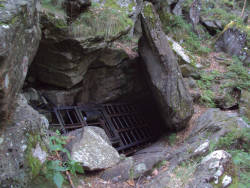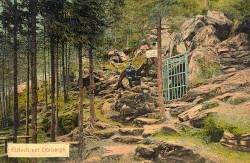Ledová Jeskyně Naděje
Eisloch
Useful Information

| Location: |
Suchý vrch, near Naděje, 6 km north of Cvikov.
(50.821451, 14.641687) |
| Open: |
closed. [2020] |
| Fee: |
closed. [2020] |
| Classification: |
 Karst Cave Karst Cave
|
| Light: |
 Electric Light Electric Light
|
| Dimension: | L=30 m, W=2-4 m, VR=6 m. |
| Guided tours: | |
| Photography: | allowed |
| Accessibility: | no, ladder |
| Bibliography: | |
| Address: |
Správa CHKO Lužické hory, Školní 12, CZ-471 25 Jablonné v Podještědí.
E-mail: |
| As far as we know this information was accurate when it was published (see years in brackets), but may have changed since then. Please check rates and details directly with the companies in question if you need more recent info. |
|
History
| 1870 | trail to the cave and wooden ladder built by the Zwickauer Bergverein. |
| 1900 | cave closed with an iron bar gate. |
| 1945 | gate broken, cave freely accessible. |
| 1966 | declared a Natural Monument. |
| 1980-82 | closed by the speleologist for temperature measurements. |
| 1988 | cave gated due to vandalism. |
| SEP-1995 | cave not accessible due to the danger of a collapse. |
Description


Ledová Jeskyně Naděje (Ice Cave Hope) is a small fissure in the phonolite of the Suchý vrch (Dürrberg) and the only Bohemian ice-cave. The cave is a fissure cave created by frost weathering, the phonolite was eroded along cracks in the rock. The crack was mostly covered by rocks which rolled down the slope and has only a small opening to the surface. During winter the cold air flows into the cave and the warm air, which is lighter, goes out. This cools the cave to temperatures below 0 °C. Water seeping into the cave creates a natural layer of ice. This ice stays long into the summer due to the cold cave, which is a cold trap. During the 19th century the ice became more than 2 m thick in spring, when melting water flowed into the cave and was frozen again. In late summer most of the ice was molten and only a thin layer was still on the floor.
This cave is a former show cave, but due to global warming the ice in the blocks above the entrance melts away during summer. The problem is that the ice actually glued the debris together and now the ceiling has become unstable. The cave was closed due to the danger of a collapse.
The cave was known under the name Eisloch, during the 19th century Bohemia belonged to the Austro Hungarian Empire and German was the official language. The development started with a trail to the cave built by the Zwickauer Bergverein in 1870. They also built a ladder which was more or less a tree trunk with steps cut into the wood. This primitive ladder allowed the descent to the 6 m deep cave floor and hikers walking to the Dürrberg could visit the cave. Later they installed a real ladder, but around 1900 they closed the entrance with an iron bar gate. Now visitors had to retrieve the key at the nearby mill Hoffnung (now Naděje) for a small fee. On sunny Sundays there was a kiosk at the cave selling tickets and refreshments. This obviously qualifies as a show cave.
We are not sure when this ended, but the obvious guess is with World War I. After the War nobody cared about the cave and at least since 1945 the cave was open because the gate was destroyed. Although the cave was declared a Natural Monument in 1966 it was not gated. Obviously people destroying some ice is not a big problem, as the ice forms and melts every year anyway. But there were also cases of fire inside the cave. Finally in 1988 the cave was gated again, and it was possible to get the permission and the key from the CHKO Lužické hory (Management of the Lusatian Mountains Protected Landscape Area). But when the blocks on top of the cave moved in September 1995 because the ice which glued them togeteher was molten, the cave was finally closed due to the danger of a collapse. We gues this is not the last word on the topic, because its likely that the block either actually collapse or find a new stable state. We expect the cave to be reopened in a few years if there is demand.
The cave was named Naděje after the small hamlet Naděje at the southern slope of the Suchý vrch. The road through Naděje goes around the mountain and on the northen side of the mountain is an artificial lake with a dam which is also named Naděje. From here a one kilometer long trail goes to the cave. There was also a steep trail to the summit but it is probably destroyed or overgrown. When the cave was operated as a show cave there was a nice view from the terrace in front of the cave. Today the whole area is covered by forest and you have to go to the summit for a view.
 Search DuckDuckGo for "Ledová Jeskyně Naděje"
Search DuckDuckGo for "Ledová Jeskyně Naděje" Google Earth Placemark
Google Earth Placemark Eishöhle Naděje
Eishöhle Naděje  - Wikipedia (visited: 22-DEC-2020)
- Wikipedia (visited: 22-DEC-2020) Ledová jeskyně (Eishöhle)
Ledová jeskyně (Eishöhle)  Index
Index Topics
Topics Hierarchical
Hierarchical Countries
Countries Maps
Maps